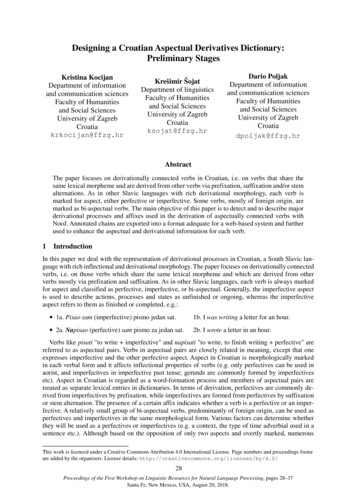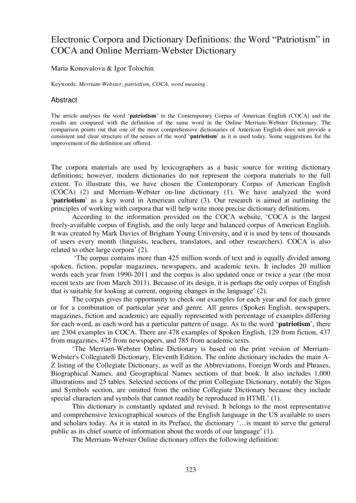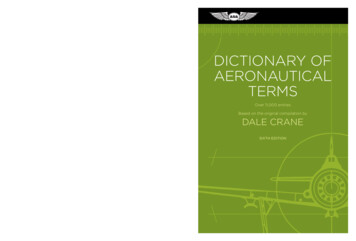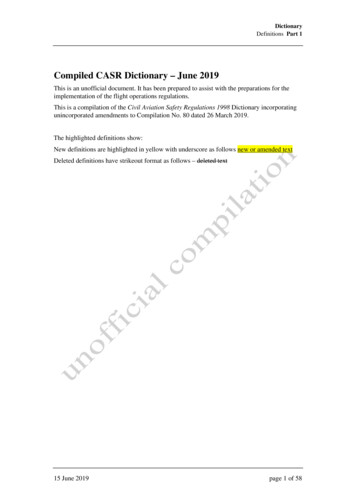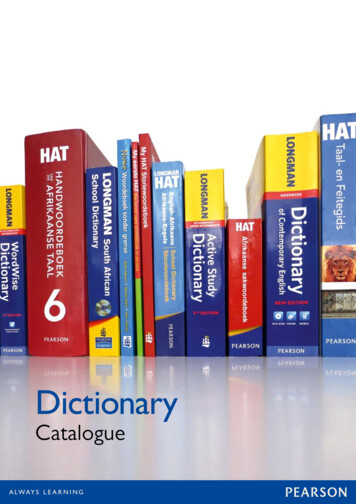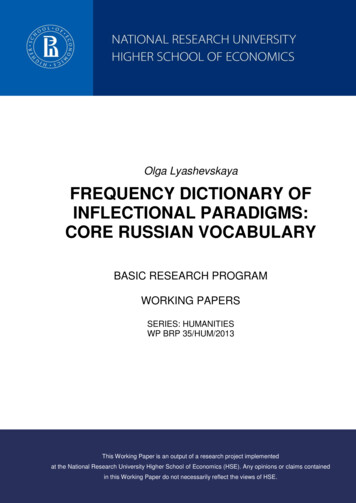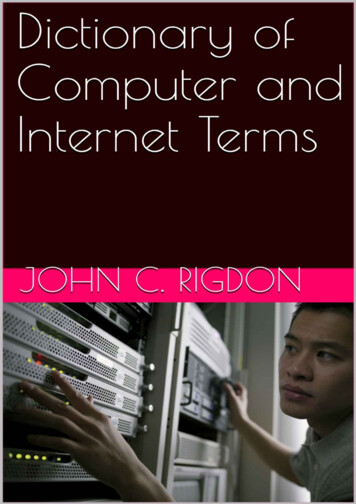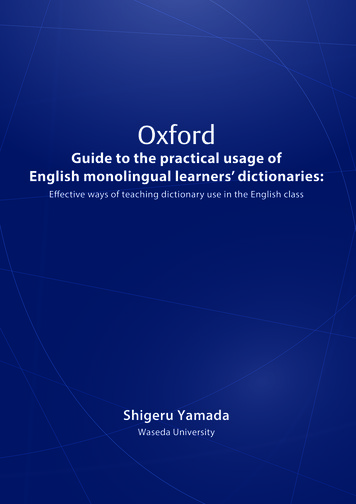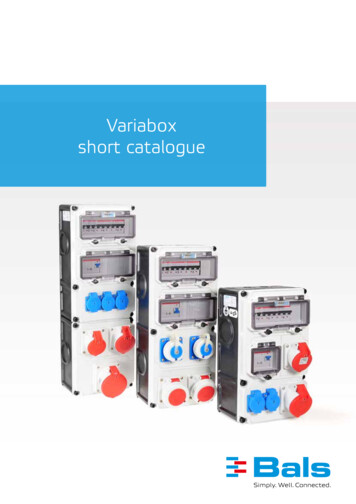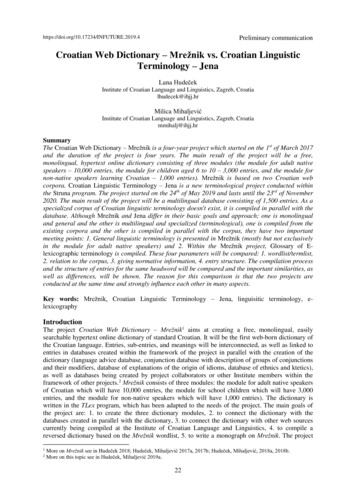
Transcription
y communicationCroatian Web Dictionary – Mrežnik vs. Croatian LinguisticTerminology – JenaLana HudečekInstitute of Croatian Language and Linguistics, Zagreb, Croatialhudecek@ihjj.hrMilica MihaljevićInstitute of Croatian Language and Linguistics, Zagreb, Croatiammihalj@ihjj.hrSummaryThe Croatian Web Dictionary – Mrežnik is a four-year project which started on the 1st of March 2017and the duration of the project is four years. The main result of the project will be a free,monolingual, hypertext online dictionary consisting of three modules (the module for adult nativespeakers – 10,000 entries, the module for children aged 6 to 10 – 3,000 entries, and the module fornon-native speakers learning Croatian – 1,000 entries). Mrežnik is based on two Croatian webcorpora. Croatian Linguistic Terminology – Jena is a new terminological project conducted withinthe Struna program. The project started on the 24th of May 2019 and lasts until the 23rd of November2020. The main result of the project will be a multilingual database consisting of 1,500 entries. As aspecialized corpus of Croatian linguistic terminology doesn't exist, it is compiled in parallel with thedatabase. Although Mrežnik and Jena differ in their basic goals and approach; one is monolingualand general and the other is multilingual and specialized (terminological), one is compiled from theexisting corpora and the other is compiled in parallel with the corpus, they have two importantmeeting points: 1. General linguistic terminology is presented in Mrežnik (mostly but not exclusivelyin the module for adult native speakers) and 2. Within the Mrežnik project, Glossary of Elexicographic terminology is compiled. These four parameters will be compared: 1. wordlist/termlist,2. relation to the corpus, 3. giving normative information, 4. entry structure. The compilation processand the structure of entries for the same headword will be compared and the important similarities, aswell as differences, will be shown. The reason for this comparison is that the two projects areconducted at the same time and strongly influence each other in many aspects.Key words: Mrežnik, Croatian Linguistic Terminology – Jena, linguisitic terminology, elexicographyIntroductionThe project Croatian Web Dictionary – Mrežnik1 aims at creating a free, monolingual, easilysearchable hypertext online dictionary of standard Croatian. It will be the first web-born dictionary ofthe Croatian language. Entries, sub-entries, and meanings will be interconnected, as well as linked toentries in databases created within the framework of the project in parallel with the creation of thedictionary (language advice database, conjunction database with description of groups of conjunctionsand their modifiers, database of explanations of the origin of idioms, database of ethnics and ktetics),as well as databases being created by project collaborators or other Institute members within theframework of other projects.2 Mrežnik consists of three modules: the module for adult native speakersof Croatian which will have 10,000 entries, the module for school children which will have 3,000entries, and the module for non-native speakers which will have 1,000 entries). The dictionary iswritten in the TLex program, which has been adapted to the needs of the project. The main goals ofthe project are: 1. to create the three dictionary modules, 2. to connect the dictionary with thedatabases created in parallel with the dictionary, 3. to connect the dictionary with other web sourcescurrently being compiled at the Institute of Croatian Language and Linguistics, 4. to compile areversed dictionary based on the Mrežnik wordlist, 5. to write a monograph on Mrežnik. The project12More on Mrežnik see in Hudeček 2018; Hudeček, Mihaljević 2017a, 2017b; Hudeček, Mihaljević, 2018a, 2018b.More on this topic see in Hudeček, Mihaljević 2019a.22
L. Hudeček, M. Mihaljević. Croatian Web Dictionary started on the 1st of March 2017, so at the moment we are in the second half of the project and morethan 5,000 entries have been compiled.The project Croatian Linguistic Terminology – Jena is conducted within the Struna program. Strunais a database of Croatian Special Field Terminology3 financed by the Croatian Science Foundation.Jena is a year-and-a-half project which started on the 24th of May 2019. The main goals of the projectare: 1. to compile 1,500 entries with definitions, synonyms, antonyms, hyponyms and equivalents inEnglish, German, French, Russian, and Swedish in the Struna database, 2. to collect works onlinguistic terminology and present them on the Jena website (ihjj.hr/jena/), 3. to write a monograph onCroatian linguistic terminology. At the moment 1035 entries have been entered into the database.However, it is important to note that both Croatian Web Dictionary – Mrežnik and Jena are conceivedas a dynamic dictionary/databases that will be further compiled and edited even after the formal endof the project funding and will not reach their full extent if they do not continue to grow and becomean everlasting project of the Institute.Hypothesis and reason for comparisonThe hypothesis of this paper is that although a terminological database obviously differs from ageneral e-dictionary there are many similarities from which both projects can profit.The reason for such a comparison is that these two projects are conducted at the same time in thesame institution, the head of Mrežnik (Lana Hudeček) is the collaborator of Jena while the head ofJena (Milica Mihaljević) is the collaborator of Mrežnik. Thus some results of one project can beapplied to the other and vice versa. In the comparison all linguistic terms which appear in Mrežnik4and the Glossary of e-lexicographic terminology compiled within the Mrežnik project are taken intoaccount. As both projects are in progress the instructions for the respective team of lexicographers andterminographers can be modified according to new results. The basic points of comparison are: 1. theways of compiling wordlist/termlist, 2. the approach to the corpus, 3. the approach to normativity, 4.the structure of dictionary entries.Wordlist vs. termlistTo compile the Mrežnik wordlist the frequency lists of hrWaC (first 12,000 words) and the Hrvatskajezična riznica (first 10,000 words) were overlapped, all words present only in Hrvatska jezičnariznica and not present in hrWaC were extracted, their frequency was multiplied by four, and theywere added to the shared list. This wordlist (first 8,000 entries) was juxtaposed with two separatewordlists: the wordlist for the module for children (which was excerpted from textbooks for the firstfour grades of elementary school with some additions by the collaborators of Mrežnik) and thewordlist for the module for non-native speakers which includes 1,000 words taken from a list intextbooks for non-native speakers, to ensure that words found in both these lists (which partiallyoverlap) appear in the list for adult native speakers. This wordlist was supplemented with male/female(in cooperation with the project Male and Female in the Croatian Language) and aspectual pairs,possessive and descriptive adjectives, adverbs derived from adjectives from the list, nouns ending in ost derived from adjectives from the list, numerous grammatical and semantic groups, etc. Thisresulted in a wordlist of 10,000 words with two separate wordlists of 3,000 words (for children) and1,000 words (for non-native speakers).The wordlist of the module for children was considered as the basic wordlist and we first begancompiling the entries for words from this list in order to make processing for the module for childrenas compatible as possible with that for adult native speakers (Hudeček, Mihaljević, 2018b).3The Institute of Croatian Language and Linguistics was chosen to serve as the national coordinator. The objective of theprogram in a broader sense is to lay the foundation for the development of national terminology policy, to establish variousforms of more structured education in this field, and to intensify long-term cooperation with national and internationalacademic and other institutions dealing with different aspects of terminology work, with the Croatian Standards Institute andwith other interested parties. Within the program, a terminology database has been developed to store andterminographically manage standardized and harmonized Croatian terms from various subject fields and their equivalents inEnglish and other languages. Experts from eighteen domains have so far joined the program with the aim of standardizingthe terminology of their respective disciplines. http://struna.ihjj.hr/en/about/.4 Of course some linguistic terms have a non-linguistic meaning which occurs in Mrežnik and doesn't occur in Jena but thiswas not the subject of our analysis.23
INFuture2019: Knowledge in the Digital AgeThe Jena termlist consisting of 1,500 terms was compiled by project collaborators divided intoworkgroups by subject fields: basic linguistic terminology, cognitive linguistics, contact linguistics,dialectology, e-lexicography and corpus linguistics, generative linguistics, glottodidactics, languagehistory, lexicography, lexicology, onomastics, orthography, phraseology, pragmatics, sociolinguistics,terminology, translation theory, valency theory. Table 1 shows a small extract from the termlistdivided by subject fields.Table 1. Extraction of Jena termlist by specialized subject fields1.1 Generativelinguistics1.6 E-jezik1.7 generativnagramatika1.8 I-jezik1.9 jezična moć1.10 jezičnasposobnost1.11 jezičnauporaba1.12 logičkiproblem jezičnogausvajanja1.13 negativnidokazi1.14 objasnidbenaprikladnost1.15 opisnaprikladnost1.16 oskudnostpoticaja1.17 pozitivnidokazi1.2 Cognitivelinguistics1.18 apsolutniprostorni sustav1.19 apstrahiranje1.20 argumentnastruktura1.21 asimetrijaizvornoga i ciljnogaokvira1.22 automatskoprepoznavanjemetafora1.23 autonomističkigramatički pristup1.24 konceptualneintegracije1.25 ciljna domena1.26 dinamičnirazvojni model1.27 dinamika sile1.28 diskursnaanalizavođenametaforom1.3 Phraseology1.29 frazeologija uužemu smislu1.30 frazeologija uširemu smislu1.31 paremiologija1.32 krilatologija1.33 zoonimnafrazeologija1.34 somatskafrazeologija1.35 internacionalnafrazeologija1.36 nacionalnafrazeologija1.37 posuđenafrazeologija1.38 arhaičnafrazeologija1.39 dijalektnafrazeologija1.40 regionalnafrazeologija1.41 frazeološkiobrat1.4 Translationtheory1.42 automatskoprevođenje1.43 doslovnoprevođenje1.44 književnoprevođenje1.45 komunikacijskimodel prevođenja1.46 ljudskoprevođenje1.47 pismenoprevođenje1.48 simultanoprevođenje1.49 slobodnoprevođenje1.50 strojnoprevođenje računalnoprevođenje1.51 traduktologija1.52 univerzalniprevodilac1.5 Languagehistory1.53 starohrvatskijezik1.54 filološkeškole1.55 zagrebačkafilološka škola1.56 zadarskafilološka škola1.57 riječkafilološka škola1.58 školahrvatskih vukovaca1.59 štokavskihrvatski književnijezik1.60 čakavskihrvatski književnijezik1.61 kajkavskihrvatski književnijezik1.62 ozaljskiknjiževno-jezičnikrugThese terms will not appear as headwords of entries or subentries in Mrežnik. However, termsbelonging to basic linguistic terminology and orthography will appear in Mrežnik as well as in Jena.Some terms belonging to basic linguistic terminology are shown in the text bellow. Figure 1 shows anextraction of the wordlist in Jena.Figure 1. General linguistic terminology from JenaThese linguistic terms will also be entries in Mrežnik.Corpus-basedBoth Mrežnik and Jena are corpus-based, and not corpus-driven. This means that the corpus and alldata extracted from it serve only as guidelines. The Glossary of E-lexicographic Terminology on theMrežnik website ihjj.hr/mreznik defines a corpus-based dictionary as follows: a dictionary for whichthe lexicographer uses a corpus, but can freely decide what should be included in the dictionary,24
L. Hudeček, M. Mihaljević. Croatian Web Dictionary allowing the dictionary to be supplemented with words from other sources if necessary, as well ascollocations and meanings not attested in the corpus. The reason for this approach is that neither ofthe corpora on which Mrežnik is based (Croatian Web Repository online c/) are representative of the Croatian language (hrWaC isprimarily based on the colloquial and journalist style and Croatian Web Repository on the literarystyle), they are not corpora of the standard language nor are they balanced corpora. It follows that, incomposing an entry, lexicographers can add meanings to a particular entry or to the collocation fieldeven if they do not appear in the corpus.Data extraction from the corpora for Mrežnik as well as for Jena is performed with the SketchEngineweb tool, which allows the display of lexeme context through WordSketches, the most commoncollocations sorted into syntactic categories and the discovery of good examples of word usage orcollocations. After lexicographic processing of Mrežnik is completed, the data will be exported fromTLex to the web application and the CLARIN European science infrastructure repository (clarin.sirepository and the github.com public data management system). This will make Mrežnik available foruse both via a web application and for machine implementation by downloading data from theCLARIN repository.Jena is based on the corpus Jezikoslovlje composed specially for the needs of the project. It consistsof a corpus of linguistic papers and monographs compiled under SketchEngine. The Jena corpuswhich has been compiled by project members and collaborators is the corpus of standard language (inthe field of linguistics) but it is as yet not representative enough. Moreover, on many modernlinguistics topics there are not many texts in Croatian and many Croatian terms have to be coined bythe authors (specialists of the particular linguistic field) themselves. From this corpus a term list hasbeen compiled which contrasted the words appearing in the corpus with the words from hrWaC. Thebasic term list is still the one created by project collaborators but it will be checked against the onecreated by Sketch Engine from the corpus so Jena will also be corpus-based. The Jena corpus is alsohelpful when creating definitions and deciding on the normative status of synonymous words.NormativityThe Croatian Web Dictionary – Mrežnik is a normative dictionary and Jena is a normativeterminological database. The normative nature of Mrežnik is apparent in the following: 1. theselection of entry-words, 2. giving normative advice in all three modules, 3. the selection of formsacceptable by the standard language norm in the grammatical block, 4. the selection of examples (thedictionary collaborators try to select examples with no language errors while examples with languageerrors are edited), 5. the accentuation of entry-words and forms in the grammatical block according tothe standard language norm.The most important normative aspect of Jena is differentiating between the preferred, allowed, nonpreferred, obsolete, and jargon terms (as will be shown in the examples below). If needed normativeadvice is given in the field note, e.g. why the preferred term is točka sa zarezom and not točka-zarezas shown in table 2.Word entries vs. term entriesTwo important meeting points of Mrežnik and Jena are 1. General linguistic and orthographicterminology is presented in Mrežnik and 2. Within the Mrežnik project, a Glossary of E-lexicographicTerminology is compiled (ihjj.hr/mreznik/page/pojmovnik/6/).General orthographic terminology in Mrežnik and JenaTable 2 illustrates the structure of the entries točka (period) and točka sa zarezom (semi-colon) inJena and compares them to the respective entry or subentry in Mrežnik:25
INFuture2019: Knowledge in the Digital AgeTable 2. Entries točka (period) and točka sa zarezom (semicolon) in Jena and Mrežnik1.64 Mrežnik1.63 Jena1.65 točka1.73 točka1.66 unesen: 01.08.2019, 20:571.74 pravop. Točka je pravopisni znak (.) koji stoji na kraju rečenicefaza obradbe: urednik pregledaote iza kratica i rednih brojeva.status naziva: preporučeni naziv1.75- Definicija mora počinjati malim slovom i nema točku nadefinicija: pravopisni znak koji stoji na kraju kraju.rečenice te iza kratica i rednih brojeva1.76 - Argument koji govori u prilog tomu da se parataktičkavrelo definicije: Jozić, Željko i dr. 2013.rečenica ne razlikuje samo formalno od dviju rečenica, tj. da se neHrvatski pravopis. Institut za hrvatski jezik imože promatrati kao dvije rečenice koje su odijeljene točkom, odnosnojezikoslovlje. Zagreb.koje se od dvorečeničnog ustrojstva razlikuju samo formalno.područje: jezikoslovlje1.77Koordinacija: točka i crtica, točka i uskličnik, točka i zarezpotpodručje: pravopis1.78Poveznica Hrvatski pravopis:jezična odrednica: imenicahttp://pravopis.hr/pravilo/tocka/55/rod: ženskibroj: jednina1.67 istovrijednica - engleski: period; fullstop1.68 njemački: Punkt1.69 francuski: point1.70 ruski: то́чка1.71 švedski: punkt1.72 simbol: 9 Comparison: Mrežnik and Jena have točka as a headword of the entry. Jena has only one meaning of točka,while Mrežnik has many meanings only one of which is the meaning in the orthographic sense. Mrežnik also has manysubentries of točka one of which is točka sa zarezom (semicolon). They have similar definitions, but while Jena givesthe source of the definition Mrežnik gives examples and collocations (coordination). These examples are taken from theJena corpus as it was difficult to find adequate examples from two corpora on which Mrežnik is primarily based. Bothare connected to the same paragraph from Croatian Orthography Manual. In Jena equivalents in English, German,French, Russian, and Swedish are given. While in Mrežnik the sign (.) is a part of the definition given in brackets due tothe very strict structure of the terminological database (brackets cannot be included in the definition) in Jena it isincluded in a special symbol field.1.90 točka sa zarezom pravop.1.80 točka sa zarezom1.81 unesen: 01.08.2019, 20:581.91Točka sa zarezom pravopisni je znak (;) koji se piše pri jačemufaza obradbe: urednik pregledaoodvajanju od onoga koje označuje zarez, a slabijemu od onoga kojestatus naziva: preporučeni nazivoznačuje točkadefinicija: pravopisni znak koji se piše pri1.92- Definicije su u kurzivu i međusobno su odvojene zarezom, ajačemu odvajanju od onoga koje označujesinonim koji nije u kurzivu odvojen je točkom sa zarezom.zarez, a slabijemu od onoga koje označuje1.93- Veoma je često u engleskome tekstu uz veliko slovo utočkaokomitome nabrajanju i točka sa zarezom.vrelo definicije: Jozić, Željko i dr. 2013.1.94 normativna napomena: U hrvatskome pravopisnom nazivljuHrvatski pravopis. Institut za hrvatski jezik iu istome se značenju upotrebljavaju nazivi točka-zarez i točka sajezikoslovlje. Zagreb.zarezom. Budući da u nazivlju istoznačenice nisu poželjne, apodručje: jezikoslovljepolusloženice se ne uklapaju u strukturu hrvatskoga jezika te ih je, kadpotpodručje: pravopisje to moguće, bolje zamijeniti istoznačnim nazivom drukčije strukture,jezična odrednica: višerječni nazivprednost se daje nazivu točka sa zarezom.1.82 istovrijednica - engleski: semicolon1.95Mrtvi sinonim: točka-zarez1.83 njemački: Semikolon1.96Poveznica:Hrvatskipravopis:1.84 francuski: arezom/62/1.85 ruski: то́чка с запято́й1.971.86 švedski: semikolon1.87 simbol: ;1.88 napomena: U hrvatskomepravopisnom nazivlju u istome se značenjuupotrebljavaju nazivi točka-zarez i točka sazarezom. Budući da u nazivlju istoznačenicenisu poželjne, a polusloženice se ne uklapajuu strukturu hrvatskoga jezika te ih je, kad jeto moguće, bolje zamijeniti istoznačnimnazivom drukčije strukture, prednost se dajenazivu točka sa zarezom.1.89 nepreporučeni naziv: točka-zarezpoveznica: http://pravopis.hr/pravilo/tockasa-zarezom/62/26
L. Hudeček, M. Mihaljević. Croatian Web Dictionary 1.98 Comparison: In Jena točka sa zarezom (semicolon) is an entry while in Mrežnik it is a subentry of the entrytočka. The reason for this is that a multiword term has the same terminological status as a single word term. They havesimilar definitions but only Jena states that the source of the definition is the Croatian Orthographic Manual. Mrežnikgives examples from the corpus while Jena has no examples. Mrežnik gives another synonymous term točka-zarez as a„dead synonym” which means it is not an entry in Mrežnik. In Jena there are no synonymous entries and točka-zarez isgiven as a non-preferred term. Both sources give the same explanation why točka sa zarezom is preferred to točka-zarezbut this explanation occurs in the note field in Jena and in the field normative advice in Mrežnik. However, both areconnected to the paragraph on semicolon from the Croatian Orthographic Manual. Both Mrežnik and Jena state that thisterm belongs to the field of orthography. In Jena equivalents in English, German, French, Russian, and Swedish aregiven. Examples in Mrežnik are taken from the Jena korpus, as it was difficult to find an adequate example in the twocorpora on which Mrežnik is primarily based.Similar results could be shown when comparing some other entries of general linguistic terms, e.g.imenica (noun), padež (case), sklonidba (declension), sintaksa (syntax).Glossary of e-lexicography and JenaGlossary of E-lexicography compiled within the Mrežnik project and in collaboration with the Jenaproject consists of names and terms relevant for e-lexicography. This Glossary is an important sourcefor Jena as from it most of the terms (not names) are taken over into the Jena database. In table 3 thecomparisons of the entries odostražni rječnik (reversed dictionary) and n-gram is shown in Jena andthe Glossary of e-lexicography.Table 3. Entries odostražni rječnik (reverse dictionary) and n-gram (n-gram) in Jena and Glossary ofe-lexicography1.99 Jena1.100 Glossary1.109 odostražni rječnik (engl. reverse dictionary) rječnik u kojemu su1.101 odostražni rječnik1.102 unesen: 04.08.2019, 18:12riječi abecedirane od kraja riječi Rückläufiges Wörterbuch desfaza obradbe: urednik uređujeSerbokroatischen (1965. – 1967.) mrežno je dostupan nastatus naziva: preporučeni esic.html.Demoinačicadefinicija: rječnik u kojemu su �iteljiceradnjeabecedirane od kraja riječi(https://borna12.gitlab.io/odostraznji-mz/, izradio Josip Mihaljević):vrelo definicije: Pojmovnik, k/6/.područje: jezikoslovljepotpodručje: e-leksikografija ikorpusno jezikoslovljedopušteni naziv: odostražnikjezična odrednica: višerječni nazivistovrijednica - engleski: reversedictionary1.103 njemački: rüchläufigesWörterbuch1.104 francuski: dictionnaire inverse1.1111.105 ruski: Обратный словарь1.1121.106 švedski: baklängesordbok;1.113 odostražnik v. odostražni rječnikfinalalfabetisk ordbok1.107 108 napomena: Nazivu odostražnirječnik daje se prednost pred nazivomodostražnik zbog sustavnoga odnosa snazivljem ostalih vrsta rječnika (općirječnik, posebni rječnik, abecednirječnik, normativni rječnik, deskriptivnirječnik, terminološki rječnik itd.)1.114 Comparison: Jena has only a definition and additional information is given in the note section. In the note thereasons for selecting odostražni rječnik as the preferred term are explained. In Jena equivalents in English, German,French, and Russian are given.1.118 n-gram sekvencija određene duljine koju sačinjavaju znakovi ili1.115 n-gram1.116 unesen: 04.08.2019, 16:41riječi koje se pojavljuju unutar teksta; pri radu s korpusima n-grami sefaza obradbe: urednik pregledaoodnose na sekvencije riječi; unigram je jedna riječ, bigram je sekvencija odstatus naziva: preporučeni nazivdvije riječi, trigram je sekvencija od tri riječi itd.definicija: sekvencija određene duljinekoju sačinjavaju znakovi ili riječi koje se27
INFuture2019: Knowledge in the Digital Agepojavljuju unutar teksta korpusavrelo definicije: Pojmovnik, područje: jezikoslovljepotpodručje: e-leksikografija ikorpusno jezikoslovljepodređeni pojam: bigram; trigram;1.119unigramjezična odrednica: imenicarod: muškibroj: jedninaistovrijednica - engleski: n-gramistovrijednica - njemački: N-Grammeistovrijednica - francuski: n-grammeistovrijednica - ruski: N-грамма1.117 švedski: n.gram1.120 Comparison: In Jena unigram, bigram, and trigram are added as subordinate terms and they have a separatedefinition. In the Glossary they are explained under n-gram but also have separate definitions in the glossary. TheGlossary is added as a source in Jena. In Jena equivalents in English, German, French, Russian, and Swedish are given.Jena vs. Mrežnik: entry structureFrom the general structure of Struna these fields have been activated for Jena (Table 4).Table 4. Fields in Jena1.1211.1231.1251.127Fieldentry wordgrammatical datadefinition1.129 field, discipline1.131 synonyms1.133 antonyms (added for thepurpose of this project)1.135 subordinate terms1.137 source of the definition1.139 equivalents in English,Russian, French, German1.141 abbreviation or acronym1.143 connectedtoothersources1.145 note1.147 phase in the compilationprocess are recorded1.122 Explanation1.124 can be a multiword entry1.126 only word class and gender and number for nouns1.128 with genus proximum and differentia specifica, not a whole sentence, startswith the small letter and does not end with a period; one term can have only onedefinition.1.130 subfields of linguistics, e.g. generative linguistics, cognitive linguistics,pragmatics, etc.1.132 divided into preferred terms, allowed terms, depicted terms, obsolete terms,and jargon terms1.134 defined in Jena by a similar definition1.136 defined in Jena1.138 if the definition was taken over from a source and not formed by thecompiler the source should be stated1.140 written (or checked) by experts for each of the languages1.142 given if any1.144 the entries are often connected to the Croatian Orthographic Manual orCroatian School Grammar, sometimes they are connected to other sources, e.g.articles in the journal Hrvatski jezik1.146 in the note relevant additional information is given1.148 different phases are: written by the author, checked by the editor, checked bythe terminologist, checked by the language editor, finishedThe diagram of the structure of Mrežnik is described in detail in Hudeček, Mihaljević, 2019a. In table5 the main differences between the structure of Jena and Mrežnik are shown:Table 5. Differences between the structure of Jena and Mrežnik1.149 Jena1.151 headword – can bemultiword, not accentuated1.153 grammatical data, wordclass or multiword – for nounsgender and number1.155 definition – one headwordhas only one definition, if neededthe same headword has multipleentries1.150 Mrežnik1.152 no multiword headwords, headwords and forms are accentuated1.154 gives much more grammatical data as well as accentuated forms1.156 a headword can have multiple senses and definitions. very often the sameentry has many meanings and only one belongs to the field of linguistics (e.g.crtica, točka, atribut) and sometimes the same word has more than one meaning inthe field of linguistics (e.g. pravopis, rječnik, fonologija)28
L. Hudeček, M. Mihaljević. Croatian Web Dictionary 1.157 field, discipline, has a listof disciplines and sub-disciplines1.159 synonyms – differentiatesbetween the preferred term,allowed term, non-preferred term,obsolete term, and jargon term1.161 antonyms – all givenantonyms are dictionary entries1.163 subordinate terms – a veryimportant field for building theterminological system1.165 source of the definition1.167 equivalents in English,Russian, French, German, andSwedish1.169 abbreviation or acronymgiven in a separate field1.171 symbols are given in aseparate field1.173 connected to other sources– mostly connected to CroatianSchool Grammar, articles fromthe journal Hrvatski jezik andCroatian Orthography Manual51.175 additionalinformationgiven in the note1.177 records the phase in thecompilation process1.179 context1.158 differentiates between linguistics, grammar and orthography, doesn’tdifferentiate between sub-disciplines1.160 gives synonyms, differentiates between synonyms that are dictionaryentries and that are not (synonyms and dead synonims), doesn’t differentiatebetween the status of synonyms1.162 differentiates between antonyms which are dictionary entries and whichare not (dead antonyms)1.164 sometimes gives subordinate terms1.166 doesn’t give data on the source of definition1.168 doesn’t have equivalents in foreign languages1.170 abbreviations and acronyms are given as synonyms and not in a separatefield1.172 symbols, if needed, are included in the definition1.174 connected to a number of sources61.176 differentiates between the pragmatic note and the normative note(language advice)1.178 doesn’t state explicitly the phase in the compilation process1.180 examples and collocationsAn important difference between Mrežnik and Jena is the approach to collocations. In Mrežnik theyhave a separate field where they are introduces by questions, e.g. What is xxx like?, What does xx do?,What can we do with xxx?, Coordination, What is mentioned in connection with xxx? In Jena there isno special collocation field and they can be either introduced as subordinate terms which than haveseparate entries, explained in the note or ignored.Results of the comparisonThe results of the comparison prove the hypothesis that two such projects as Jena and Mrežnik can becompared and that they can mutually profit from each other and such a comparison. The results of thecomparison are shown in table 6.Table 6. Comparison of
L. Hudeček, M. Mihaljević. Croatian Web Dictionary 23 started on the 1st of March 2017, so at the moment we are in the second half of the project and more than 5,000 entries have been compiled. The project Croatian Linguistic Terminology – Jena is conducted within the Struna program.Struna is a database of Croat
